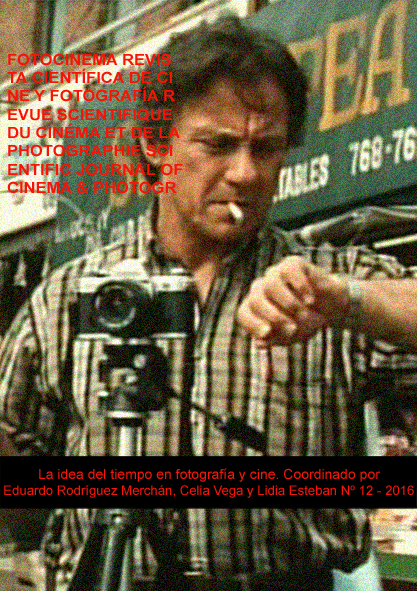Fotografía, tiempo y desaparición: la imagen de la barbarie en la Guerra de Canudos
DOI:
https://doi.org/10.24310/Fotocinema.2016.v0i12.6034Abstract
El artículo parte de las fotos históricas que muestran la destrucción y las víctimas de la ciudad de Canudos. Estas imágenes demuestran que las fotografías históricas sólo adquieren significación plena dentro del contexto discursivo proporcionado por el historiador. Las fotos de Canudos, que contradicen el objetivo último pretendido por el ejército al encargarlas (la defensa de la división entre civilización y barbarie), permiten comprender que la singularidad de la fotografía se encuentra en el hecho de elaborar un pasado exterior a la conciencia. Se utiliza en el análisis de las fotos el concepto de punctum. Esta categoría barthesiana no sólo sirve para pensar la dolorosa sensación de paso del tiempo que se experimenta al contemplar la fotografía histórica, sino también para reflexionar sobre el campo ciego que otorga a las imágenes fotográficas el estatuto de incompletas. Finalmente se defiende que la fotografía se corresponde con una peculiar estética de la desaparición. Se trata de una estética que, en primer lugar, identifica la imagen fotográfica con una huella dejada por algo ausente o desaparecido; y que, en segundo lugar, responde a la cuestión de cómo mostrar lo desaparecido –las víctimas de Canudos– sin crear una imagen idólatra.
Abstract:
This paper is based on the historical photos that show the destruction and the victims of Canudos settlement. These images are used to showcase the fact that historical or old photos only acquire full meaning within a discursive context provided by the historian or by the images of memory. The photographs of Canudos -which contradict the ultimate aim of the Army in commissioning them (the defence of the division between civilization and barbarism)– enable to understand that the singularity of photography lies in the fact that it elaborates a past exterior to conscience. The concept of punctum is also used in the analysis of the photographs. This Barthesian category is used not only to think of the painful feeling of time going by one experiences when contemplating historical photography, but also to reflect on the blind field that conveys photographs the status of incomplete. Finally, this paper argues that photography corresponds to a particular aesthetic of disappearance. Firstly, this aesthetics identifies the photographic image with the trace left by something missing or that has disappeared; and, secondly, it answers to the question of how to showcase the disappeared -the victims of Canudos– without creating an idolatrous image.
Palabras clave:Barbarie; inconsciente óptico; campo ciego; tiempo; imagen idólatra; desaparición.
Keywords:
Barbarity; Optical Unconscious; Blind Field; Time; Idolatrous Image; DisappearanceDownloads
Metrics
Downloads
Published
How to Cite
Issue
Section
License
All contents published in Fotocinema Revista científica de cine y fotografía are protected under the Creative Commons Attribution-NonCommercial-ShareAlike 4.0 International (CC BY-NC-SA 4.0) license. All about this license is available in the following link: <http://creativecommons.org/licenses/by-nc-sa/4.0>
Users can copy, use, redistribute, share and exhibit publicly as long as:
- The original source and authorship of the material are cited (Journal, Publisher and URL of the work).
- It is not used for comercial purposes.
- The existence of the license and its especifications are mentioned.
There are two sets of authors’ rights: moral and property rights. Moral rights are perpetual prerogatives, unrenounceable, not-transferable, unalienable, imprescriptible and inembargable. According to authors’ rights legislation, Fotocinema. Revista científica de cine y fotografía recognizes and respects authors moral rights, as well as the ownership of property rights, which will be transferred to University of Malaga in open access. The property rights are referred to the benefits that are gained by the use or the dissemination of works. Fotocinema. Revista científica de cine y fotografía is published in an open access form and it is exclusively licenced by any means for doing or authorising distribution, dissemination, reproduction, , adaptation, translation or arrangement of works.
Authors are responsable for obtaining the necessary permission to use copyrighted images.













13.png)




